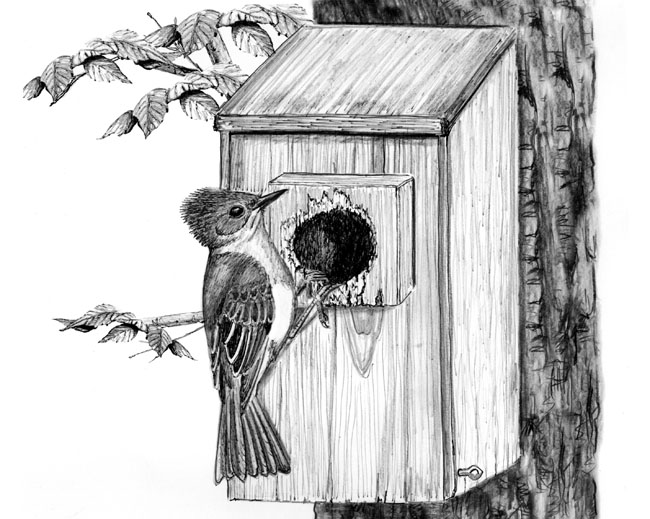
Dear Bird Folks,
Over the winter a squirrel enlarged the hole in one of my birdhouses and ruined it, or so I thought. I was just about to stop into your store and buy a new birdhouse when I noticed this strange bird looking out of the hole (see attached photo). I believe the bird is a Great Crested Flycatcher. This is the first time I’ve ever seen one of these birds in my yard. Are they rare around here?
– Dave, Sandwich, MA
What a sad story, Dave,
I was moments away from selling you a brand new birdhouse, only to have my hopes dashed when a flycatcher occupied your old house at the last moment. Talk about a cruel twist of fate. I think I’m going to be depressed for the rest of the summer. Of course, you know I’m kidding. They are one of my favorite birds. How can you not love a bird called a “Great Crested Flycatcher”? It sounds like a title bestowed on someone in the British Empire. I can just hear a British official announcing, “By order of the Queen, I now dub you: Great Crested Flycatcher of Nottingham.” Or something like that.
It seems every fall when the leaves come off the trees, I discover a recently used bird nest that I didn’t know about. Somehow a bird was able to build a nest, lay its eggs and raise a family right under my nose, without me knowing about it. But when Great Crested Flycatchers nest in your yard you’ll know it, your family will know it and your neighbors will know it. They talk incessantly, giving their diagnostic “weeeep” call throughout the day. Great Crested Flycatchers are common summer residents. So no, they aren’t rare. But they may seem rare because not everybody sees them. When they aren’t calling, or moving in and out of a birdhouse, they can be overlooked. Much of the time Great Crested Flycatchers sit high-up in a tree, searching for insects, or just enjoying the view. (Actually, there is no research that suggests birds like to enjoy a view of any kind. But I have a customer who insists they do, so I added that line to keep her happy.)
Even though this bird is called a “flycatcher,” it doesn’t really catch that many flies. Most of its diet consists of moths, bees, butterflies, grasshoppers and crickets. Flying insects are caught on the wing, while crickets are captured on the ground. It’s interesting to note that even though Great Crested Flycatchers feed on the ground, they have no terrestrial skills. If a hunting bird misses a cricket or grasshopper, it doesn’t pursue it by running or hopping after it. Instead, the bird will take off, fly up into the air and then fly back down after its prey. (It seems flycatchers want to build up their air miles as much as the rest of us.)
Great Crested Flycatchers build their nests inside of tree cavities, but apparently they spend too much of their energy building up those air miles, because they don’t have the strength to dig their own cavities. They are totally dependent upon natural cavities or old woodpecker holes. Great Crested Flycatchers will also use man-made birdhouses. Unfortunately, very few birdhouses have openings large enough to accommodate them. Most houses are designed to attract bluebirds and thus have only 1-1/2” entrance holes. But these flycatchers are a little too chunky to squeeze into such small holes. (Apparently, crickets go right to their hips.) As a result, Great Crested Flycatchers are left out in the cold. Or are they? This is where everybody’s pal, the squirrel, enters the picture. Squirrels have their own hip issues and they too can’t squeeze into a 1-1/2” holes. But unlike flycatchers, squirrels have carpentry skills. It only takes a few minutes of chewing for 1-1/2” hole to become a 2” hole, which is perfect for Great Crested Flycatchers. (Well, perfect once the squirrels move out.)
Just because Great Crested Flycatchers don’t have the ability to dig out their own tree cavity, it doesn’t mean they don’t know how to build and decorate their nests. Like a lot of small birds, flycatcher nests contain basic nesting material, including grass, leaves and rootlets. But these birds also add a bit of material that has kept researchers scratching their heads for centuries. It seems Great Crested Flycatchers like to decorate their nests with lovely snakeskin. Yes, snakeskin, and no one knows why. Some officials think the added snakeskin deters predators (I know it would keep me away), but others disagree. And if the flycatchers can’t find snakeskin, they will substitute pieces of waxed paper, cellophane or even onionskin, which explains why the nests frequently contain an air freshener as well.
As I mentioned earlier, Great Crested Flycatchers are common in the summer, but only the people who have appropriate nest boxes are likely to see them. That’s a hint to all of you birdhouse builders out there. Take a break from making bluebird boxes and build a flycatcher box. Or better yet, go to the nearest birding store and buy one…or two.
I’m glad you have Great Crested Flycatchers living in your yard, Dave. They might not be rare, but their sounds and antics make them fun birds to have. In a few weeks, when the babies have flown away, you should open the box and look for that snakeskin we talked about. It will be interesting to see if there is some in there. Also, while you’re at it, look for an air freshener. Wouldn’t it be freaky if the birds actually had one?